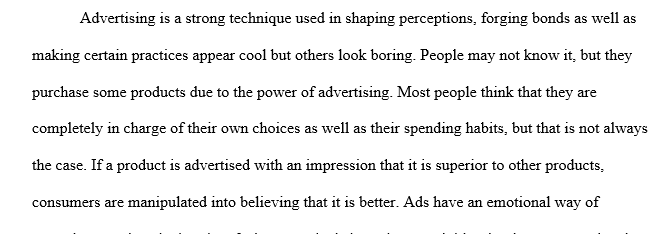Advertising and Consumption Patterns
#1 Advertising and Consumption Patterns
How does advertising shape our consumption patterns? Give specific examples from your own experience
#2 Consumerism and Competition
Which vision is it:
Consumers are at the mercy of big business/media oligopolies and must be rescued by the government or
If the marketplace is allowed to operate freely, big business/media oligopolies will come and go and the laws of supply and demand will prevail to the consumers’ benefit?
#3Public Relations
Please examine the week 5 PowerPoint on Public Relations. What is public relations? How significant and valuable is public relations in today’s media environment? Based on your own experience, which is more influential, public relations or advertising?
#4 Magazine Advertising (Student Post)
According to our book, with the expansion of the railroads and advantageous postal rates fueled the explosive growth of the popular magazine just before the end of the 19th century. The Ladies’ Home Journal of 1883, was the magazine that married magazines and advertising. By the turn of the century, magazines were financially supported primarily by their advertisers rather than by their readers, this we can find it very common today. When we pick up a magazine at the store or the subscription we might have, it comes with so much advertising that sometimes it can be too much. I personally feel that advertising has become too much and it’s hard to pay attention to one, much less the hundreds of them that pop at us from everywhere we stand.
Baran, S. J. (2017). Introduction to Mass Communication Media Literacy and Culture (9th ed.). Retrieved fromhttps://phoenix.
#5 Industrialization and the Civil War (Student Post)
Our book talks about how the Civil War altered the social and cultural landscape and how it brought about the expansion of advertising. By means of the telegraph, communication was possible over long distances. The railroad could link cities and states, as well as huge numbers of immigrants, were welcomed to the United States to provide labor for the expanding factories. Advertising copywriter Volney B. Palmer recognized in 1841 that merchants needed to reach consumers beyond their local newspaper readership. He contacted several Philadelphia newspapers and here he agreed to broker the sale of space between them interest advertisers. The Civil War sped industrialization, which meant that more factories needed to produce war material, roads and railroads were expanded. Many farmers went to war or to work in new factories and more farm machinery was needed to compensate for their departure. Soon enough, the telephone and electricity were invented and new innovations in manufacturing exploded as well as the availability of products.
Baran, S. J. (2017). Introduction to Mass Communication Media Literacy and Culture (9th ed.). Retrieved fromhttps://phoenix.
#6 TEDTalks: Don’t Like Clickbait? Don’t Click
Watch “TEDTalks: Don’t Like Clickbait? Don’t Click.”
Reflect on and discuss the following:
What does the speaker mean by shaping the world with our clicks? What happens when we click on clickbait? Where’s the harm in receiving targeted content that is tailored to your interests?
#7 TEDTalks: Rory Sutherland: Life Lessons From an Ad Man
Watch “TEDTalks: Rory Sutherland: Life Lessons From an Ad Man,” located on this week’s Electronic Reserve Readings page.
https://fod-infobase-com.
Reflect on and discuss the following:
Sutherland speaks of the concept of value and of placing value on the intangible. Is addressing intangible value a part of contemporary advertising? What current television ads spark your interest and influence your buying habits? Why?
Solution preview for the order on advertising and consumption patterns
APA
938 words
